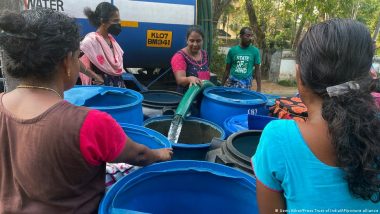Extreme weather events including heat waves, floods, cyclones and rising sea levels have resulted in a rise in climate-induced migration in India. Experts suggest the problem is set to get worse.Protima Rai still remembers the aftermath of tropical Cyclone Bulbul that struck the Sundarbans in 2019 leaving behind a trail of destruction and lost lives.
Also Read | Nepal: Indian Mountaineer Anurag Malu Goes Missing From Mount Annapurna.
The cyclone that had formed in the Bay of Bengal forced Rai, 27, and hundreds of other families from to migrate from their village to safer areas.
Also Read | Hyderabad: Newly Opened US Consulate To Process Around Visa 3500 Applications per Day.
Climate change forces people to move on
"The fields were not fit for cultivation. Rising sea levels and increasing salinity deprived the people living in the core Sundarbans areas of their main sources of livelihood — which is agriculture and fishing," Rai told DW.
Substantial migration from the Sundarbans still continues on a permanent, seasonal and temporary basis. According to the Rural Household Survey, over 25% of the principal earners of individual families migrated temporarily searching for work.
The Sundarbans is a cluster of low-lying islands in the Bay of Bengal, spread across India and Bangladesh, famous for its unique mangrove forests. The Indian Sundarbans has 104 islands in total, of which 54 are inhabited by humans.
Environmentalists point out that coastal erosion and rising sea levels are gradually eating away at the land in the Sundarbans. Many people from the villages are being forced to migrate to cities, like Kolkata, because their fertile land is turning saline with an increasing number of storms and floods.
No political plan to help
"There is no structured policy or action plan from the administration to provide social protection in countering climate change and related migration," Jayanta Basu, a Kolkata-based environment and climate expert, told DW.
The eastern state of Odisha is also an important source of migrant workers, and climate change plays an important role in increasing vulnerabilities, pushing people in search of work.
Over the years, the Chilika Lake, the largest brackish water lagoon in the state and an important bird area, has been exposed to changing environmental conditions, impacting the livelihoods of the local people.
"Employment options are limited after extreme weather events hit Mangalajodi town on the northern banks of the lake. Many have decided to move out permanently," Sugyan Behera, who works in the tourism industry, told DW.
The town has a population of 10,000 people, mostly engaged in work around the wetlands.
Climate migration is often influenced by extreme events — such as storms, floods, and droughts — or slow-onset events — like sea levels rising or saline water intrusion into agricultural land.
A report published in December 2020 by ActionAid and Climate Action Network South Asia showed that even if the global community acts on their greenhouse gas (GHG) mitigation pledges and targets, about 37.5 million people will still be displaced by 2030 and an estimated 62.9 million by 2050, across five South Asian countries — Bangladesh, India, Nepal, Pakistan and Sri Lanka.
Highest number of displacements
India alone will see 45 million people being forced to migrate from their homes by 2050 due to climate disasters — three times the current number number of people on the move as a result of extreme weather events.
According to the "State of India's Environment-2022" report, India is the fourth worst-hit country in the world when it comes to climate change-induced migration, with more than three million people forced to leave their homes in 2020-2021.
The highest number of migrations took place in China with more than 5 million people driven out of their homes due to weather-related disasters.
Sunita Narain, director of the Centre for Science and Environment (CSE), points out that given the impacts of the climate crisis, it is essential to invest in building local climate resilience and protecting economies.
In an extensive study across 15 states, CSE found that wherever such an investment had been made, it brought benefits to villages while stemming migration. In fact, in villages where water harvesting was organized and ecological resources were used for the benefit of locals, reverse migration started.
Narain referred specifically to the Mahatma Gandhi National Rural Employment Guarantee Act (MGNREGA), a social security measure that aims for rural folk to safeguard their 'right to work.'
"You can change the future. It does not have to be a story of climate distress driving migration. The value of MGNREGA and such schemes is to invest in ecological infrastructure that bolsters local livelihoods and community resilience, crucial in the era of climate change," Narain told DW.
Abinash Mohanty, sector head of climate change and sustainability at IPE Global, an international development organization, also maintained that India needs to map the sectoral impacts through hyper-granular risk assessments to restrict climate cataclysm, in particular the issue of climate-induced migration.
Climate-induced migration not taken seriously enough
"Limiting migration calls for conducive policies and action plans, especially that can climate-proof climate-sensitive sectors like agriculture and tourism, among others. While India has a robust climate action plan both at the national and sub-national level, it hardly encompasses climate-induced migration as a pivotal issue," Mohanty told DW.
India records some of the highest numbers of displacements in the world every year, the vast majority of them triggered by disasters.
According to the Internal Displacement Monitoring Centre (IDMC) in India there are currently about 14 million people who have been displaced due to climate change.
Though migrants receive immediate support in terms of relief and rehabilitation in the aftermath of these disasters, there is little long-term institutional support for their needs.
A 2021 study, 'Climate induced displacement and migration in India' found that people are migrating to escape poverty because of collapse of traditional livelihoods and the dismal infrastructure that is failing due to climate change.
In the hilly districts of Uttarakhand, erratic rainfall patterns and a receding water table has forced people to abandon their homes and farms to migrate to the plains. In Saharsa district of northern Bihar, a relocated community continues to be overwhelmed by incessant floods.
"Inter-state and intra-state (rural-urban) migration due to drought, floods and other extreme events have been taking place in the country for a long time and it is widely acknowledged that nature of this migration has changed due to increasing frequency of climate induced extremes," Chandra Bhushan, founder of International Forum for Environment, Sustainability & Technology, told DW.
"While states have started to seriously look the issues of migrants since COVID 19, there are no separate policy or initiatives for climate induced migration," added Bhushan.
Edited by: John Silk
(The above story first appeared on LatestLY on Apr 19, 2023 10:20 PM IST. For more news and updates on politics, world, sports, entertainment and lifestyle, log on to our website latestly.com).













 Quickly
Quickly





















